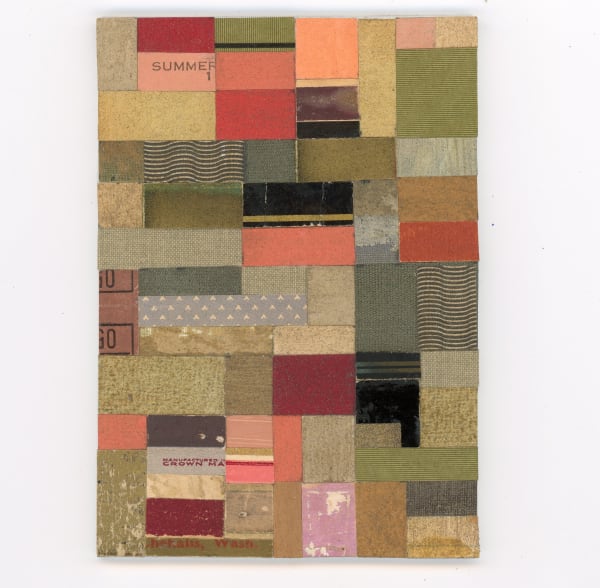-
 Ato Ribeiro, Melitta's Gift, 2022
Ato Ribeiro, Melitta's Gift, 2022 -
 Ato Ribeiro, Untitled (Wooden Kente Quilt #61), 2024
Ato Ribeiro, Untitled (Wooden Kente Quilt #61), 2024 -
 Break Patterns
Break Patterns -
 Debussy
Debussy
-
 Andy Burgess, Familiar Comforts, 2023
Andy Burgess, Familiar Comforts, 2023 -
 Andy Burgess, Confessions, 2023
Andy Burgess, Confessions, 2023 -
 Normandy
Normandy -
 Andy Burgess, Cantato, 2023
Andy Burgess, Cantato, 2023
Transcendent Geometries:
Ato Ribeiro | Carrie Marill
with Andy Burgess
Exhibition Dates:
March 2 - May 25, 2024
Opening Reception with the artists:
Saturday, March 2, 2024
1:00 - 3:00pm
In a time dominated by machine algorithms, a return to patterns made by human hands and touched by human bodies can produce transcendent geometries, reminding us of our origins as embodied and sensuous beings. Ato Ribeiro, Carrie Marill, and Andy Burgess work in diverse media, yet each artist employs pattern as an instrument of exquisite narrative and intimate intention. Working within formal geometrical guidelines that often resemble the composition of a quilt - an object used both to warm people and communicate information - Ribeiro, Marill, and Burgess combine tactile materials, mathematical constraints, and the universal need for expression to create intimate graphic explorations in wood, acrylic on linen, and textile collage. Their recent works will be exhibited in a group show at Lisa Sette Gallery from March 2 - May 25, 2024.
Ato Ribeiro constructs vibrant compilations of motifs, patterns, and structures that multiply and evolve before the viewers' eyes. Handmade of salvaged scrap wood - a metaphor for the bodies of historically disadvantaged peoples - Ribeiro's arrangements of hand burnished wood pieces and right angles form voluminous landscapes of pattern and movement, celebration and remembrance. A collector of symbols and stories as well as wood, Ribeiro formulates these works with reference to his Ghanian background and the diverse cultures of the African diaspora, blending the patterns of Kente cloth and African American quilts - objects worn close to the skin and signifying family, status, and values - as well as the formulations of griot storytelling, woman-led justice work, and his own extensive travels. From this rich personal background Ribeiro draws forth ever more expansive communications of action, intimacy, and family. Ribiero remarks that these works "serve as a reflection of the people, the histories, and the cultural fabrics that I continue to learn from and share in. These works are a collection of stories, fragmented and fused together with room for the addition of narratives to come… This assemblage of histories pays homage to my three-times great grandmother Priscilla (Marshall) Young, interactions with griots, and my desire to share space and stories with Madan Sara in Haiti. The materials that make up these works are the same ones that make up the hard and soft woods hidden behind white gallery walls. Here, they are optimistic for the future because they know from whence they came."
The artist Carrie Marill speaks of her "love for combining worlds," and her research and practice examining pattern, color, and form in both folk and fine art result in works that are luminously personal and formally precise. Marill lists the contrasts that inspire her, from "craft and architecture, masculine and feminine, beauty and utility" to "hard and soft, structure and freeform, handwork and mechanization." In Marill's recent works, inspired by her study of European modernist architects and folk quilts, the artist delineates these human contrasts in geometrical explorations. The personal characteristics of built spaces and objects are tangible in these works: the simple physique of a chair, the human spaces around which a building is built, the soft precision of a quilt made from textile remnants already worn close for a lifetime. "I have been looking at architecture and how the patterns found in modern/minimalist architecture utilize similar patterns as found in quilt making. Architecture can create light, airy space out of steel, metal and concrete. Could quilts create a similar effect? What if a building were a quilt? I want to capture that in a painting."
Similarly, Andy Burgess's elegant assemblages of found textiles and paper ephemera recall deeply personal architectures: the receding horizons of imaginative cityscapes, the parallel and bisecting lines of books standing vertically in a shelf, or the intricate repeating unit of a quilt square. Burgess explores space and pattern with references to the modernist movement and "the place of collage within that history, exploring the aesthetic legacy of Cubism, Bauhaus, Dada, and Constructivism." Yet within these compositional strategies, Burgess values the touch and texture of his materials above all, selecting his compositions from a vast tactile catalog of found materials documenting human lives and the materials we use and discard: "I make art from the most humble and lo-fi materials…found ephemera, discarded papers and card, and recycled offcuts from previous works. The more dejected and rejected, dog-eared and forlorn are my materials, the greater the possibility that a careful repurposing and delicate arrangement of elements can turn the abject into something beautiful and poetic… By making humble and small-scale works from repurposed materials that are full of imperfections; uneven and worn surfaces, tears, fissures, cracks, and fractures, I hope to make a small statement about the continued vitality and significance of the hand-made art object."
Ribeiro, Marill, and Burgess's generative action through geometrical constraint creates patterns, structures, and moments of introspection, accessing experiences of interior consciousness and human sensuousness. These works evoke an awareness of the shapes and patterns that humans have constructed, touched, broadcast, and lived within for centuries and throughout the world. Their distinct graphic explorations speak of the shape of human curiosity and variety, and our simultaneous ability to organize the symbols and structures of our lives into lucid moments of sensation and self-knowledge.

































